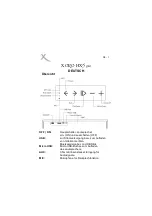
4. Connect one stripped end of the speaker cable coming from the amplifier to the
RS6 connection cable’s red wire. To connect the two wires, twist the stripped
ends of the wire together and screw down the wire nut on the twisted wires. The
material inside the wire nut will protect the stripped ends of the wire. However, if
added protection is desired, place a large amount of silicon sealant so the bottom
of the wire nut is encased and sealed. Pay attention to the markings on the
speaker cable. Each loudspeaker you connect must be connected to the
amplifier’s speaker wire in the same way.
5. Repeat step 4 with the RS6 connection cable’s black wire and the other stripped
amplifier speaker cable’s conductor.
6. Connect the opposite end of the speaker cable to the amplifier or receiver. Start
by performing step 1 and 2 on the speaker cable near the amplifier. Paying
attention to the markings on the speaker cable conductor, attach the same
conductor you attached to the red loudspeaker wire to the positive (red) or (+)
amplifier output terminal. Attach the other conductor to the amplifier’s negative
(black) or (–) amplifier output terminal.
Speaker Phase
Speaker wire has two conductors. One conductor is attached to the negative (black)
or (-) terminals and one conductor is attached to the positive (red) or (+) terminals of
both the loudspeaker and the amplifier. Usually, the wire is marked for your
convenience. There are different ways to mark the conductor; a stripe on one wire,
a ribbed area on one conductor that you can feel, different color metal conductor
wire inside the insulation, the insulation covering the conductor might be different
colors, or there might be a fabric string wound onto one of the conductors. Of
course some cables make it difficult to determine which conductor is which. Be
careful to avoid mistakes. If you do, one loudspeaker will be playing out of “phase”
with the other loudspeaker. An out of phase pair of speakers work against each
other and the sound of the two speakers playing together will be lacking in bass
response and have a “phasey”sound quality. If you suspect the sound is not right,
check to make sure that the conductors on each loudspeaker are attached the same
on the loudspeaker and the amplifier. If you cannot see any markings or determine
if they are all attached the same, try this simple test:
INST
ALLA
TION
11
Figure 6 Speaker wire preparation










































